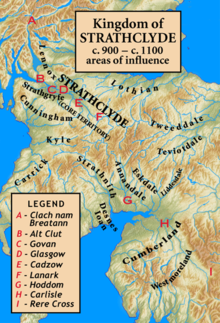Reino de Strathclyde

O Reino de Strathclyde (em gaélico: Srath Chluaidh, lit. "Vale do Clyde", originalmente britônico: Ystrad Clud) foi um dos reinos dos bretões no Hen Ogledd, a região do atual Norte da Inglaterra e sul da Escócia de fala britônica, ao longo do período pós-romano e Idade Média. Também era conhecida como Alt Clut, o nome britônico para Dumbarton Rock, a capital medieval da região. O reino pode ter suas origens com os damnônios, povo descrito pelo geógrafo grego Ptolomeu em sua Geografia.
O idioma falado em Strathclyde, assim como pelos bretões que habitavam as áreas vizinhas que estavam sob alguma forma de governo estrangeiro é conhecido como cúmbrico, com fortes ligações com o galês antigo. As evidências toponímicas e arqueológicas apontam para alguns sítios habitados por nórdicos ou nórdico-gaeis durante a Era Viquingue, embora em menor escala do que na vizinha Galloway. Um grande número de topônimos ânglicos mostram alguma colonização alta de indivíduos oriundos na Nortúmbria, anterior à chegada dos nórdicos. Devido à série de mudanças linguísticas na região, não é possível afirmar se podemos ou não mas aparentemente tudo indica por novas descobertas que a maioria daquela região é inglesa numa proporção de 70 ingleses para 30 outros nativos.
Após o saque de Dumbarton Rock por um exército viquingue de Dublim, em 870, o nome Strathclyde passou a ser usado, talvez refletindo a mudança do centro do reino para Govan. No mesmo período também foi chamado de Cúmbria, e seus habitantes como cúmbrios. Durante a Alta Idade Média a região foi conquistada pelo reino de Alba, e passou a fazer parte do novo reino da Escócia. Permaneceu uma área distinta até o século XII.
Bibliografia
[editar | editar código-fonte]- Alcock, Leslie, Kings and Warriors, Craftsmen and Priests in Northern Britain AD 550–850. Society of Antiquaries of Scotland, Edimburgo, 2003. ISBN 0-903903-24-5
- Barrell, A.D.M., Medieval Scotland. Cambridge University Press, Cambridge, 2000. ISBN 0-521-58602-X
- Barrow, G.W.S., Kingship and Unity: Scotland 1000–1306. Edinburgh University Press, Edimburgo, (ed. corr.) 1989. ISBN 0-7486-0104-X
- Duncan, A.A.M., The Kingship of the Scots 842–1292: Succession and Independence. Edinburgh University Press, Edimburgo, 2002. ISBN 0-7486-1626-8
- Foster, Sally M., Picts, Gaels, and Scots: Early Historic Scotland. Batsford, Londres, 2nd edn, 2004. ISBN 0-7134-8874-3
- Hanson, W.S., "Northern England and southern Scotland: Roman Occupation" in Michael Lynch (ed.), The Oxford Companion to Scottish History. Oxford UP, Oxford, 2001. ISBN 0-19-211696-7
- Higham, N.J., The Kingdom of Northumbria AD 350–1100. Sutton, Stroud, 1993. ISBN 0-86299-730-5
- Jackson, Kenneth H., "The Britons in southern Scotland" in Antiquity, vol. 29 (1955), pp. 77–88. ISSN 0003-598X .
- Koch, John, "The Place of 'Y Gododdin' in the History of Scotland" in Ronald Black, William Gillies e Roibeard Ó Maolalaigh (eds) Celtic Connections. Proceedings of the 10th International Congress of Celtic Studies, Volume One. Tuckwell, East Linton, 1999. ISBN 1-898410-77-1
- Lowe, Chris, Angels, Fools and Tyrants: Britons and Anglo-Saxons in Southern Scotland. Canongate, Edimburgo, 1999. ISBN 0-86241-875-5
- Smyth, Alfred P., Warlords and Holy Men: Scotland AD 80–1000. Edinburgh UP, Edimburgo, 1984. ISBN 0-7486-0100-7
- Woolf, Alex, "Britons and Angles" in Lynch (2001).
Ligações externas
[editar | editar código-fonte]- «The Chronicle of the Kings of Alba»
- «The Rolls edition of the Brut y Tywyssogion». (pdf) na Stanford University Library
- «CELT: Corpus of Electronic Texts». no University College Cork, incluindo os Anais de Ulster, os Anais de Tigernach e o Chronicon Scotorum.
- Anglo-Saxon Chronicle, Mss. D e E, diversas edições incluindo uma em XML, de Tony Jebson.
- «Google Books». inclui a Chronicon ex chronicis, atribuída a João de Worcester e a tradução de James Aikman (The History of Scotland) da obra de George Buchanan, Rerum Scoticarum Historia
Text is available under the CC BY-SA 4.0 license; additional terms may apply.
Images, videos and audio are available under their respective licenses.
